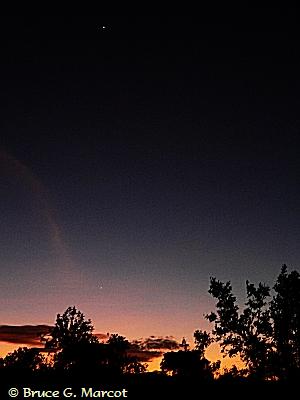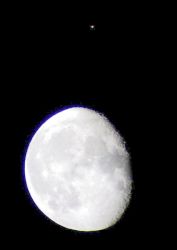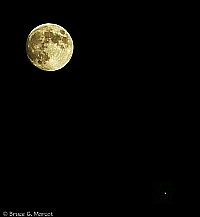Click on thumbnails for larger images.
All photos taken by and © Bruce G. Marcot.
Stars
& Planets ... the stuff of kids' dreams
A
Close, New Year Passage ... The Moon & Jupiter
A
Close April Passage ... Jupiter & the Beehive Cluster (M44)
A
Near Lunar Occultation of Mars
Amazing Martian Oppositions
Stars
& Planets ... the stuff of kids' dreams
A seldom-photographed sight ... Venus and Mercury in the pre-dawn sky.
Venus is the bright dot at top, and Mercury is the dimmer dot just below the tree line.
What makes this an uncommon sight is that the two planets are aligned vertically in the sky. This is because I photographed the scene from just below the equator, from the Masai Mara grasslands of southern Kenya, Africa.
On the equator, the celestial equator plunges into the
horizon at near-right angles ... so the planets form vertically over the dawn
sky.

The overwhelming immensity of the night sky. Time exposure of
star trails circling Polaris (upper left corner) over the distant, dwarfed
lights of a small town in the valley far below. Taken from Horse
Mountain in the Klamath Mountains of northwestern California. One
of my real favorites.

Star trails. Taken August 1980 during the Perseid meteor shower
(28mm lens, 400 ASA film). Note the wandering red blinking light
of an airplane, in the upper right. The multiple colors result from
the sensitivity of the film. Taken in Oregon.

Dusk, a new crescent moon with earthshine, and Venus, the Evening Star.
Taken in northwestern California.

Dawn, a late crescent moon with earthshine, and Venus, the Morning
Star. Taken in the foothills of the Himalayas, northern India.

Do you recognize the three belt stars of this famous constellation,
the hunter, hiding behind a tree in wait of its quarry?
![]()
A
Close, New Year Passage ... The Moon & Jupiter
On December 29-31, 2001, Jupiter passed within a few degrees of a nearly full Moon.
At this time, Jupiter was in opposition to Earth, just 4.19 astronomical units (AUs) apart (one AU = the mean distance between Earth and the Sun or about 93 million miles). At opposition, Jupiter is directly opposite the Sun in the sky and is at its closest approach to Earth, so it is also at its brightest, registering an apparent magnitude of -2.7. That's bright, considering that the brightest star in the Northern Hemisphere sky, Sirius, is only -1.60 (the lower the number, the brighter the object).
The Moon was 98% full at this stage and waning.
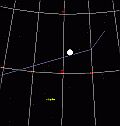
I created this image with the "Distant Suns 4" program, showing the
relation of Jupiter and the Moon at 10:10 p.m. on 29 December 2001.
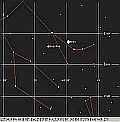
This image is from "EZCosmos 4.0" for the same date and time.
The orientation is a little different.
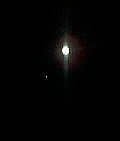
And here is the actual view of Jupiter and the Moon as I recorded with
my digital camera on the same date and time, taken from Tigard, Oregon.
The last time Jupiter was at opposition to the Earth on New Year's Eve
and New Year's Day was in the year 1752, and it won't be again until 2084!
![]()
A Close April Passage ... Jupiter & the Beehive Cluster (M44)
On April 3, 2003, Jupiter paused in its retrograde motion across the sky within one degree of the Beehive Cluster (M44).
This was a beautiful sight in 10x binoculars ... which I experienced for the brief hour of clear sky in the middle of nearly a solid week of overcast and rain.
Jupiter - the bright one - with the Beehive Cluster, just emerging from
behind an old Oregon white oak.

A closer inspection.

Jupiter and the Beehive -- look carefully for a hint of the Galilean
moons.
Indeed, 3 Galilean moons were visible:
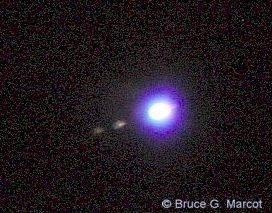
From left to right, the 3 moons are Callisto, Ganymede, and (just off
the right limb) Io.
Compare the above photo to a screen shot from the
astronomical program
RedShift4 for the same date, time, and location:
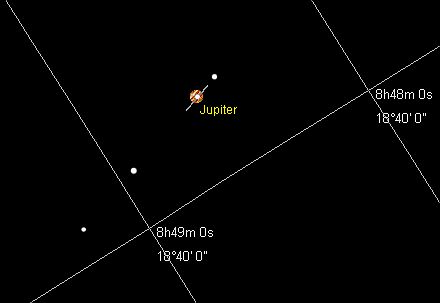
That's Europa dead center on the disk of Jupiter.
![]()
A
Near Lunar Occultation of Mars
On July 26-27, 2003, for part of southeastern North America Mars passed behind the Moon. This is called an occultation (the Moon occults, or eclipses, Mars).
The occultation per se was not visible from my northern Oregon view, but by 1:30 a.m. local time on July 27th, the waning gibbous Moon had risen far enough so I could view it and Mars within half a degree separation. This was a beautiful scene, as during Summer 2003 Mars has its closest approach to Earth in 60,000 years! Mars was shining bright and steady like a tiny red laser dot.
Click on these thumbnails for full views:
![]()
Amazing Martian Oppositions
During
summer 2003, Mars and the Earth approached each other closer
than they have ever been in about 60,000 years. Here are two photos
of brilliant Mars in the early evening sky, looking southeast, from a suburb
outside Portland, Oregon, where usually all but the brightest stars are
masked by "urban fog" of city lights.

On 15 November 2005, Mars was intensely bright and arced within about 1.5
degrees of a near-full Moon.
